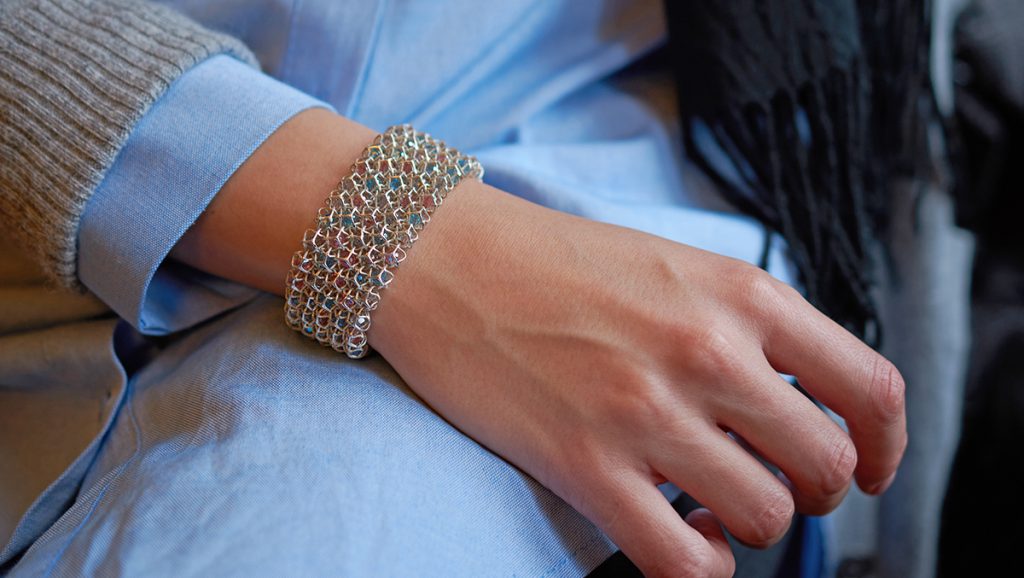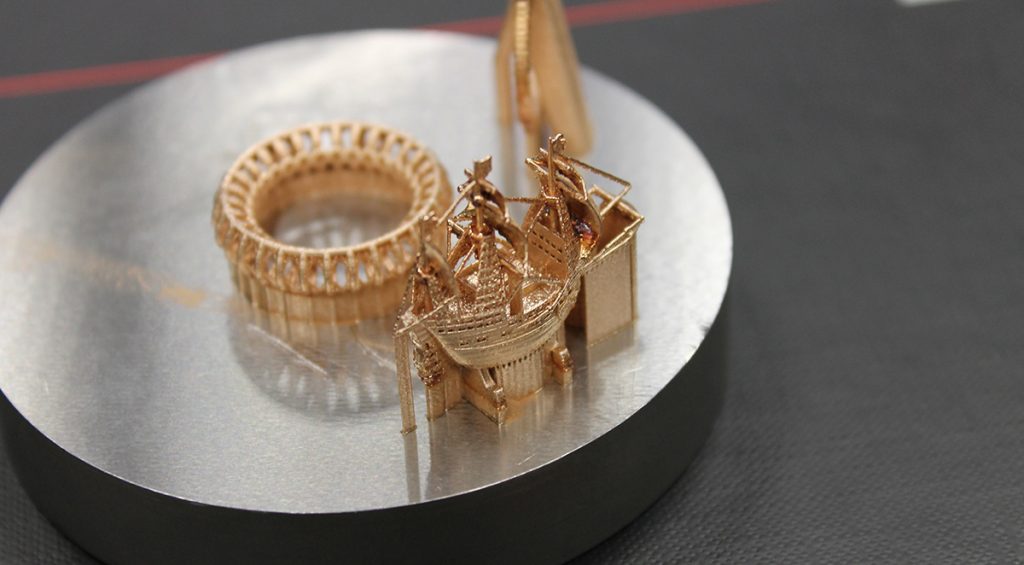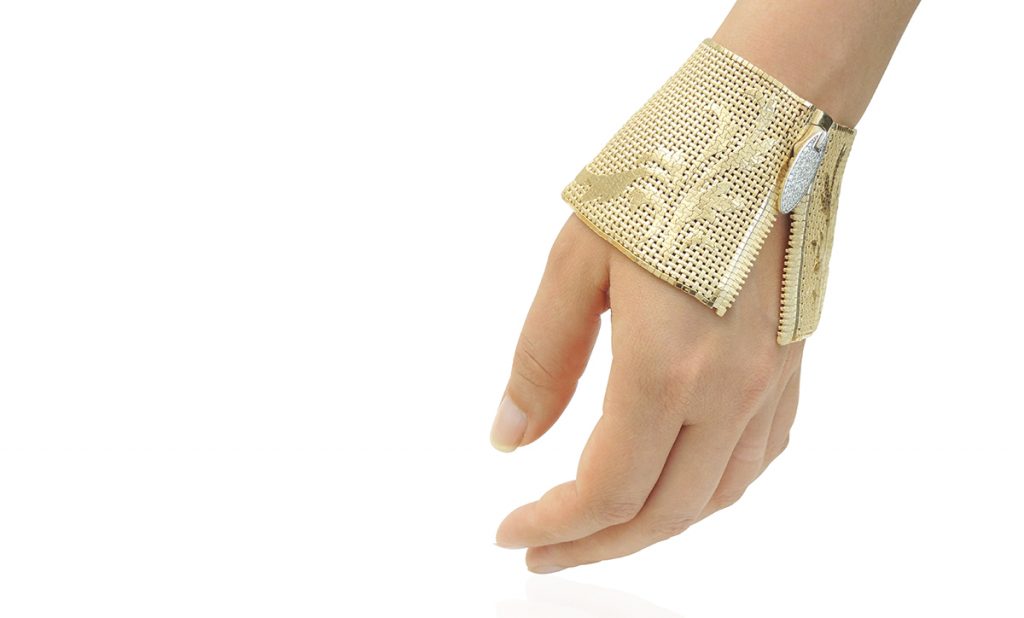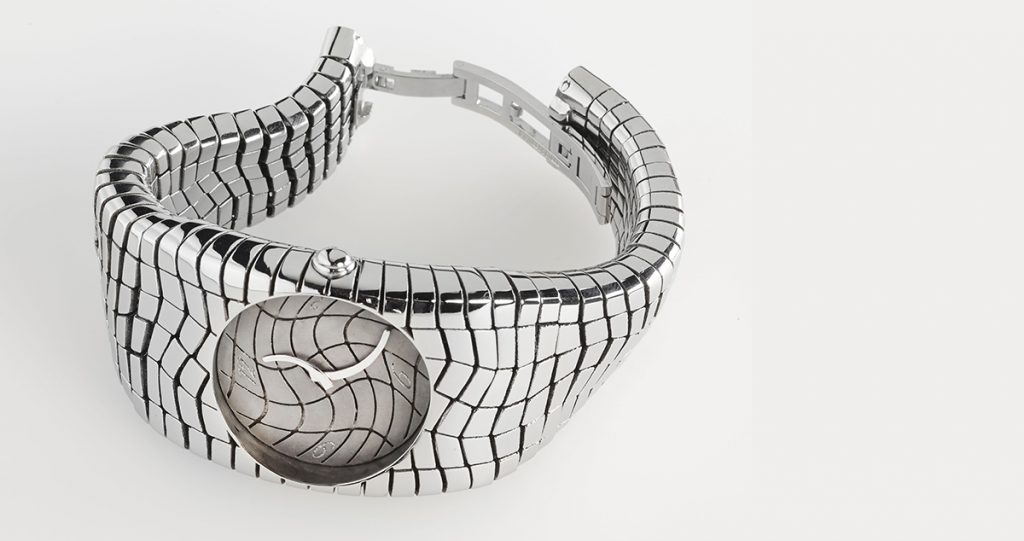Innovation and differentiation: Precious metal Additive Manufacturing in the jewellery sector
Rich in creativity and rooted in a long artisanal manufacturing heritage, one would imagine that there can be few sectors as perfectly suited to embrace the potential of metal Additive Manufacturing than the jewellery industry. In reality, however, the sector continues to hold back on the full-scale adoption of AM, despite numerous successes. In this article, Michela Ferraro-Cuda considers progress to date in the adoption of precious metal AM in the jewellery industry, and showcases a number of leading designers who have leveraged the technology’s potential for innovation and differentiation. [First published in Metal AM Vol. 6 No. 2, Summer 2020 | 25 minute read | View on Issuu | Download PDF]

Jewellery is a multifaceted and complex sector which is almost impossible to consider as a single industry. This is in part because of cultural influences that play a significant role in differentiating the types of jewellery produced, and in part because of how jewellery is manufactured. Based on a particular culture, nationality and market, bespoke, small series or large series collections might be more likely. Considering the evident differences between the type of jewellery made by a skilful artisan or an artist, and jewellery produced on a large or even medium scale, it appears clear that the processes and technologies involved will differ – sometimes substantially. It is essential to comprehend these aspects of the jewellery industry in order to understand how precious metal Additive Manufacturing, based mainly on Laser Beam Powder Bed Fusion (PBF-LB) technology, has challenged the sector to find its own niche.
Given the value of the materials used, the added value of jewellery manufactured by an artisan is based on the fact that it is handmade (with the support of tooling), whereas for a piece of jewellery manufactured with faster, technology-based processes, the added value is based on the perfect replication of the same design, in small or large scale, at a lower cost than if it had been handmade. Regarding the artisan aspect of production, further discussion is needed on whether the value is different when AM is involved for part of the production process, or the entire process is based on the hand-modelling skills of an artist or artisan. This is a discussion that will not find an easy conclusion, if any.
The backstory of AM in the jewellery industry

Wax model makers were in high demand until around fifteen to eighteen years ago; their ability to produce, for example, a mirrored model for a pair of earrings, was particularly highly valued. These sculptural skills were not widely available in the market, but the models they produced were the foundation for any casting production run. Thus, it was important for companies to reserve their ‘spot’ with model makers for each new collection from one season to another.
The advent of Computer Aided Design (CAD) software and the associated rapid prototyping processes – in essence the first examples of Additive Manufacturing – had a great impact on this aspect of the jewellery industry. Faster and more efficient prototyping ensured that, first, larger companies (which could afford to invest in this new technology) and, later, medium and even small companies (via a growing number of service bureaux) were able to maximise their production lines, speed up collection launches and optimise their related investments.
Reactions to the arrival of this new technology varied: some complained that designers no longer used their creative talents, instead merely exploiting the design features offered by CAD, while others focused on the new, unexploited potential of CAD and rapid prototyping technologies. The advent of new innovations in design and manufacturing always challenges the status quo, and the jewellery sector – perhaps due to its traditional heritage – is among the most suspicious of new technologies.
Despite this initial suspicion, fast prototyping processes had a very successful evolution in the industry and, in the years that followed, the range and types of equipment available to produce wax or resin models for casting greatly increased. For some jewellery collections, it is preferable to additively manufacture a wax or resin ‘tree’ with the models attached ready for casting. This offers significant advantages for volume production, eliminating some process steps, saving time and keeping costs low.

It goes without saying, of course, that over the years the jewellery industry has fully adopted other processes such as stamping, electroforming and CNC machining for medium to large production runs or to provide semi-finished/finished parts. However, these processes require higher upfront investments and must be used to manufacture very high numbers of a product to amortise the cost. These production processes, therefore, are preferred for collections where consistent and large scale production is planned, or for collections with a higher mark-up, such as those by luxury brands.
So where in this landscape does precious metal Additive Manufacturing fit?

The arrival of precious metal AM in the jewellery market was met with curiosity and enthusiasm, especially among production departments and product developers. The immediate question was how both AM manufacturers and potential adopters could evaluate the potential of this new technology. The immediate approach was to make a comparison against pieces of jewellery already manufactured using other technologies. I remember reading with great curiosity the papers published on successful trials carried out in the aerospace industry, where metal AM could reduce the weight of some parts, or enable mechanical parts to be manufactured in one piece rather than several assembled pieces. In the jewellery industry, the same exercises did not yield such positive results. It is true that reducing weight in jewellery is one crucial factor, given the price of precious metal, but it is not the only one. In fact, the same comparison exercise, investigating how a piece of jewellery currently produced by casting or CNC would perform if produced by metal AM, could be very misleading.
A 2016 study carried out by Bulgari [1] reported on several trials undertaken by the company. The company’s team compared parts of their jewellery collection, in precious and non-precious metal, made by the direct casting of an additively manufactured resin model, against pieces made by metal AM. The main aspects analysed by this study were density and conformity. The study is thorough and detailed, taking into consideration several metals and alloys, and represents a huge and extensive analysis comparing elements made using the two different techniques. However, from the beginning, precious metal AM has had a disadvantage, which made it challenging for jewellery making: the surface quality of as-built parts. Even if using the right combination of parameters (scan speed, laser power, etc) might offer the desired quality, Bulgari’s team found that the process time required to produce the piece to the necessary quality would be too extensive, defeating the original purpose.
However, having talked recently with Ivano Torresan, CEO of Italian jewellery producer Nuovi Gioielli and an early adopter of AM for precious metals, his approach is simple: if a product already performs well when manufactured using a selected technique, why should we consider switching the production method to Additive Manufacturing? The answer, of course, is that we shouldn’t. Or at least – we more than likely shouldn’t.
The investment involved in adopting a manufacturing method such as precious metal AM should not be considered for those pieces of jewellery that can already be produced perfectly well using their current production method; where it should be considered is where the use of AM enables designers to challenge the norm and produce jewellery designs, which would be impossible to make by any other available manufacturing technique. This is the key.

Damiano Zito, CEO of Progold S.p.A., makes almost the same argument – he states that precious metal AM should be adopted where it enables the creation of new production paths, such as the production of a piece of jewellery in an alloy that would be problematic to process using casting, such as platinum or titanium. In particular, he highlights how titanium Additive Manufacturing has opened up new opportunities for jewellery brands and emerging designers. Titanium is much lighter than the traditional precious metals used in jewellery, and thus offers the advantage of creating large, statement pieces without affecting wearability. Precious metal AM has offered the opportunity for designers to think about jewellery production in a different way.
This seems to be the key point of precious metal AM: that it allows manufacturers and designers to think in a way that was not possible before. Frank Cooper, Senior Lecturer and Centre Manager at the Centre for Digital Design and Manufacturing, within Birmingham City University’s Institute of Jewellery, Fashion and Textile, agreed, underlining how this technology offers the unique possibility “to produce items of absolute complex geometry,” as long as designers understand the principles behind the precious metal AM design process, such as what can be additively manufactured without compromising the finishing process.
This takes us back to surface finishing, which, along with build quality, remains fundamental for any product to be appreciated and accepted in the jewellery industry. Back in 2017, when I was completing my MBA dissertation on the adoption of precious metal AM in the jewellery industry, surface quality was confirmed as the most common barrier. While surface quality may not have a significant impact on a mechanical part’s performance (and, in most cases, aesthetics for mechanical parts are not a high priority), surface quality and aesthetics are crucial considerations when deciding whether to pursue Additive Manufacturing in the jewellery industry.

Other interviewees from the aerospace and automotive industries were surprised to find that this element was such a key factor in our industry; but the reality is that this has been the foremost issue that has kept precious metal AM on the sidelines for some time. There are, of course, many common requirements between a high performance mechanical application in, for example, the aerospace industry and a high quality piece of AM jewellery. Both require flawless manufacturing to full density, totally free from porosity, in order to, in the one industry, deliver the necessary mechanical performance and, in the other industry, to be polishable to the required level of an international jewellery label.
Additionally, the difficulty of adequately eliminating surface defects left by the supports needed during a product’s build and, at the same time, obtaining a smooth and homogeneous surface has undermined the decisions of potential adopters. In the jewellery world, the potential of precious metal AM is met with great enthusiasm by makers and designers, but, when the time comes to invest capital in the technology, decision makers have remained dubious. In some of the conversations I had with professionals three years ago, a common idea was that, if this issue was not resolved, the major players in the field, be they the famous brand luxury jewellery designers or famous watch manufacturers, would not move beyond sampling or testing precious metal AM and this decision would have an important impact on the rest of the industry’s perception of the technology. Now it seems that we are still waiting for a resolution.

However, this situation has challenged the developers of precious metal AM technology and the manufacturers of precious metal alloys to improve the performance of their systems and the quality of metal powders used. In my conversations in 2017, some operators specified that first trials had been conducted using the same grade of powder alloy as used for casting, which was indicated as a possible cause for the poor consistency and results achieved. In a recent conversation, though, Damiano Zito clarified that, at the very beginning of Progold’s research, the same powder gave different results when used in two different metal AM machines. This suggests that, for precious metal AM, a combination of different factors must be considered to achieve optimal results.
So, where are we three years later? The investments made by alloy manufacturers have been noticeable, thanks in large part to the adoption of advanced metal powder atomisation technology to improve powders performance. As a result, the surface quality of precious metal AM products is now far less rough and much easier to finish. Damiano Zito confirmed this point, saying that precious metal AM “is ready”, but there remains the need to find objects that are actually worth additively manufacturing.

Design for AM and the need for jewellery-specific education
Ivano Torresan is confident that “the technology is mature,” and with it the market is accepting precious metal AM. However, what is still missing is the essential factor: designers capable of getting the best from it. Frank Cooper confirmed, from his perspective as a lecturer, that as a technology it is mature, “if the designers understand how to get the best from it.” Evidently, the factor now keeping the technology on ‘stand-by’ is the need to create designs that can push this revolutionary technology to its maximum capabilities. As stated before, there is no benefit in using Additive Manufacturing to produce jewellery which is already well-suited to production by casting.
This challenge should not be underestimated, because the result of the need for new design knowledge is a peculiar transition time. Old-school designers, such as myself, are trained to think in terms of subtractive technologies and the new concept of adding materials within the rigorous parameters of Additive Manufacturing requires a complete change of mindset.

During my conversation with Ivano Torresan, he suggested that new generations of designers should be taught Additive Manufacturing from as early as primary school, because the new way of thinking involved in designing for AM will be the future. Frank Cooper explained how, within his programme at the School of Jewellery (today part of the Birmingham Institute of Jewellery, Fashion and Textile), students are taught the two separate different approaches, stressing the major differences between designing for casting and designing for Additive Manufacturing.
To promote the technology, Cooksongold sponsors a dedicated category for precious metal AM at the Goldsmiths’ Craft and Design Council Awards. Cooksongold ensures that, in advance of submissions to the competition, special educational sessions are delivered to those students who intend to participate, explaining in detail the specifics of precious metal AM and providing a dedicated illustrated guide. As a major promoter of AM, with a passion for the technology, I participated myself, mostly to challenge my capacity to envision designs suitable for AM, without forgetting the importance of the fundamentals of jewellery design (Fig. 10). I managed to come in third place for two years in a row, pushing me to think smarter for my next attempt!

Progold, too, through collaborations with Istituto Europeo di Design (IED) of Turin and other international design schools, is proactively promoting precious metal AM. With the aim of “transferring knowledge and expertise”, students are invited to design the best pieces, balancing style and suitability for AM. The Progol3D® award ceremony is held yearly during Vicenzaoro January, the international event for the gold and jewellery industries.
It is evident that education is essential if the industry is to introduce and train new engineers and designers to the advantages of precious metal AM; for example, knowing how an object will be positioned on the build plate and consequently supported, means engineers and designers must also understand how the spots left on the surface of the part by the removed supports will impact the finishing process. An awareness of the entire process required to design, additively manufacture and complete a piece of jewellery is needed in order to guarantee the exceptional quality expected for precious items.
The ability to produce highly detailed bespoke jewellery is without doubt one of precious metal AM’s most interesting features, especially in light of the jewellery sector’s recent movement towards more personal and emotional experiences; why, then, not revise collections to produce smaller, more bespoke ones? When considering the great flexibility that AM offers, although the investment required to adopt this technology may be higher than for most other solutions, the product cycle as a whole must be considered. Damiano Zito commented that, often, even if the cultural approach permits a user to positively evaluate AM as a production technology, it seems that the industry is still missing the capacity to evaluate its potential.
Ivano Torresan highlighted another interesting point: high-end jewellery brands often struggle to consider AM as an option because of the lack of available statistics on its use. Their new product development processes need figures and numbers to determine whether or not to invest in a certain project; without such figures, the enthusiasm shared by product development and production teams cannot find its way to the decision makers. It is more likely that emerging designers will have a greater opportunity to take advantage of AM, because of their more flexible internal organisation and desire to showcase the uniqueness of their designs.

An example of a fine jewellery company and an emerging designer collaborating to take advantage of their respective positions in relation to precious metal AM adoption was highlighted by Frank Cooper. Cooksongold recently partnered with Marie Boltenstern, a jewellery designer based in Austria, who produces entire collections using precious metal AM (Fig. 1, Fig. 11). She has developed special interlinked designs to exploit the full capabilities of the technology, as well as encasing precious beads by interrupting the PBF-LB build process. Her brand image takes full advantage of the use of AM and the uniqueness it brings to her designs, with the tagline ‘3D printed fine jewellery’ featuring heavily across the label’s communications.


Interlinked and modular designs are, without doubt, one of the best ways to showcase the capabilities of precious metal AM for jewellery. Products using these designs include Nuovi Gioielli’s the ‘Zip bracelet’, with its fabric-like pattern (Fig. 12), and the ‘PixYourTime’ watch (Fig. 13). Damiano Zito highlighted, as one of the best applications of this, the plain hollow volume rings produced by Progold (Fig. 14), which eliminate the need to solder parts together, as would have been required if produced with the lost-wax casting process.

What’s next for precious metal AM in the jewellery industry?

The conversation I had with Damiano Zito revealed some interesting progress: the development of composite precious metal alloys such as AuNb and AuTi (Fig. 15). Alloy development and production is Progold’s core business, so it comes with no surprise that its investments are now focused in this direction. During the 2016 Santa Fe Symposium, an annual conference for the global jewellery industry, Zito presented a paper which introduced the concept of mixing the powders of two different metals, such as gold and titanium; the results were promising and deserve further investigation, including from the point of view of style. The alloys currently available for precious metal AM through three selected providers are shown in Table 1.

Conclusion
There is a clear consensus in the industry that, despite the technical readiness of precious metal AM, a lack of courage and willingness to change currently hinders its adoption in the jewellery industry. What is needed is a cultural revolution, to create an industry mindset which is capable of envisioning the new opportunities the technology offers, with more open-minded and visionary managers and decision makers, willing to think beyond the traditional processes.
In the last three years, precious metal AM has made little impact in the industry. It appears to be stuck in ‘waiting mode’, as the industry learns that, while it is not going to replace any other production technology, it is worth developing the knowledge and understanding to take advantage of what it can offer. All of the professionals interviewed for this article agreed on the need to create more opportunities for knowledge exchange and sharing in this area.

Perhaps it would be worthwhile to create a dedicated event just for precious metal AM. Creating a common platform would optimise the industry’s efforts to exchange knowledge and understand where the technology fits in the industry, support the message that it has something to offer and help to engage the major players, other interested parties and final customers.
This is necessary as, following the arrival of precious metal AM, an impactful change or shift in the industry simply has not happened; we now need to join forces and promote dedicated studies on the potential of such innovative technology in the jewellery sector as a whole and not just individually. Metal AM technology can bring both innovation and differentiation in what is already a dynamic and creative sector – why not join the efforts?
Author
Michela Ferraro-Cuda is Course Director, MA Luxury Jewellery Management, and a Lecturer in Luxury Jewellery and Ethical Branding, at Birmingham City University, UK. She is also a freelance jewellery consultant dedicated to researching new combinations of precious and alternative materials, combining new technologies with artisan traditions.
[email protected]
Acknowledgments
Thanks go to the following interviewees for their time in the preparation of this article.
Ivano Torresan
CEO of Nuovi Gioielli S.R.L. (Mussolente, Vicenza, Italy), an early adopter of the very first version of My Sint 100 by Sisma S.p.A.
Damiano Zito
CEO of Progold S.p.A. (Trissino, Vicenza, Italy), an alloy manufacturer and AM service bureau.
Frank Cooper
Senior Lecturer and Centre Manager-Centre for Digital Design and Manufacturing at Birmingham Institute of Jewellery, Fashion and Textile, part of Birmingham City University. Frank has widely carried out trials and experiments with the EOS M080 by Cooksongold.
References
[1] ‘Case Study of Problems and Their
Solutions for Making Quality
Jewelry Using Selective Laser
Melting (SLM) Technology’, Christina Pogliani and Alberto Albertin,
Bulgari Gioielli S.p.A., as presented at the 2016 Santa Fe Symposium. Retrievable from www.santafesymposium.org/2016-santa-fe-symposium-papers/2016-case-study-of-problems-and-their-solutions-for-making-quality-jewelry-using-selective-laser-melting-slm-technology







